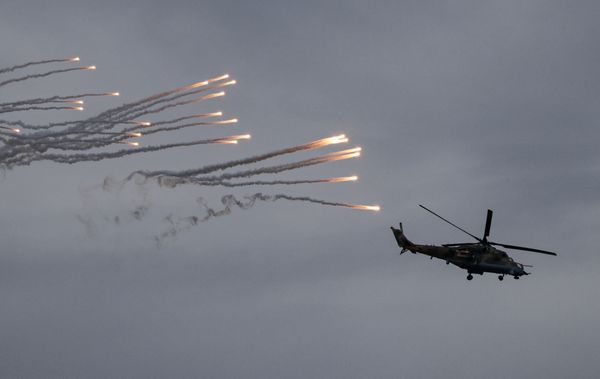Lockheed Martin stock angled lower Wednesday following a report that the Pentagon halved its request for F-35 jets for the Air Force this year. The Pentagon is requesting $3.5 billion for its next-generation fighter jet, called the F-47, according to Wednesday reports. Small cap tech play Ouster soared after the Department of Defense approved the company's lidar technology for military drones.
The Air Force last week asked for 24 of the F-35 fighter jets, down from 48 last year, Bloomberg News reported citing a U.S. Department of Defense procurement request sent to Capitol Hill. The Air Force plans to seek $3.5 billion for the aircraft, and $531 million for advanced acquisition of materials.
The Pentagon requested 12 of the Navy's carrier version of the F-35, while Congress approved 17 for the fiscal year. The Marines would also see two fewer planes in this year's funding.
Meanwhile, Lockheed's CFO Evan Scott said in May that the contractor expects a finalized contract on its F-35 jets to be awarded in the second half of this year. Scott, speaking at a Bank of America conference, said that a definitive contract could come by the end of June. The executives previously expected to land deals for two separate lots of jets, with the first finalized in the first half of the year and the second by the end of 2025, BreakingDefense reported.
Lockheed's F-35 have been hammered by delays related to a technology upgrade. The defense contractor delivered 110 F-35 jets to the U.S. and its allies in 2024. The program represents about 30% of Lockheed's revenue, according to Reuters.
Lockheed Martin Stock Falls On Wednesday
Lockheed Martin stock fell 4.2% Wednesday to drop below its 50-day line.
LMT stock is down 6% so far this year.
Lockheed Martin has a 21-day average true range ratio of 1.82%.
The average true range is a metric available on IBD's MarketSurge that gauges the characteristic breadth of a stock's behavior. Stocks that tend to make large jumps or dives in daily action, the kind that can trigger sell rules and shake investors out of a stock, have a high ATR. Stocks that tend to make more incremental moves have lower ATRs.
With the S&P 500 and Nasdaq now in a power trend, investors can buy stocks with ATRs up to 8%, though they should be wary of being too concentrated in high-octane names.
NGAD Request
The Pentagon is also requesting $3.5 billion for its F-47 Next Generation Air Dominance (NGAD) program this year, Aviation Week reported Wednesday. Defense Secretary Pete Hegseth outlined the spending plan on Tuesday during testimony for the House Appropriations Defense subcommittee.
The sixth-generation fighter jet looks to replace Lockheed's F-22 Raptor. Boeing in March won an estimated $20 billion contract from President Donald Trump to develop the aircraft.
The $3.5 billion request is up slightly from the Pentagon's previous fiscal 2025 spending plan, which requested $3.19 billion for the NGAD program.
The $3.5 billion will likely include $400 million for the F-47 that is included in a $150 billion reconciliation package that passed the house and is under consideration by the Senate, according to Aviation Week.
Meanwhile, the Air Force is poised to make a production decision on the first increment of its Collaborative Combat Aircraft (CCA) program. These unmanned drones will essentially serve as wingmen to various piloted advanced aircraft.
The Air Force will also move forward on a second increment this year. The Pentagon will request $804 million for CCAs in fiscal 2026.
However, fiscal 2026 deliberations are in their early stages. The Pentagon still has four months left in fiscal 2025 with no budget in place, Aviation Week reported.
Ouster Drone Tech Approved
Elsewhere, San Francisco-based autonomous tech company Ouster received a stamp of approval from the Department of Defense.
The DoD has reviewed, tested and approved Ouster's OS1 digital lidar for use in unmanned aerial systems (UAS), the company announced Wednesday. The Defense Innovation Unit approved and added the Ouster OS1 to the Blue UAS Framework. Blue UAS is a holistic approach to rapidly vets and scales commercial UAS tech for the DoD. The Framework is an approved list of interoperable, National Defense Authorization Act-compliant components and software for the government and industry partners.
Ouster's OS1 is the first high-res 3D lidar sensor approved under the Blue UAS Framework. The company says it offers "superior performance" in weight, power efficiency and reliability in rugged conditions compared to previously-approved 2D lidar solutions.
OUST stock rallied 27% Wednesday.
Shares ended Wednesday up 69% from a double-bottom entry after breaking out on May 28. Shares have a 66.6% gain in 2025.
Ouster has a 21-day ATR of 7.57%.
You can follow Harrison Miller for more stock news and updates on X/Twitter @IBD_Harrison







